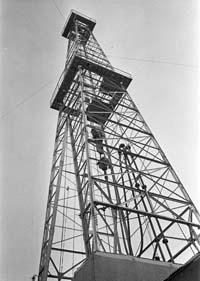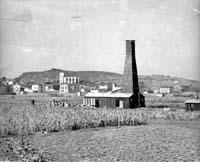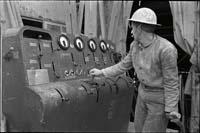Oil surveys in the Basque Country

It is not sure that there is oil in one place until the land surface is punctured and the local area is analysed. All this was well learned, especially by the Spanish, German and French institutions that approached the Alava province in search of oil. In fact, in the 1970s they were convinced that in Alava the probability of finding oil was enormous.
"Why especially in Alava?" probably more than one ask. One of the most outstanding features of oil is its mobility and migration capacity. This capacity allows oil to sometimes reach the land surface. In these cases, fossil remains such as bitumen or asphalts that impregnate the rocks appear. In some villages of Alava, such as Maeztu, Atauri or Peñacerrada-Urizaharra, there are fossil remains of this type.
On the other hand, the accumulation of hydrocarbons requires certain traps or geological structures such as anticline or diapiros. And they also saw that the underground geography of Alava had important anticlinals and diapiro. Therefore, in Alava the conditions for finding oil were optimal. Therefore, XX. During the whole twentieth century oil was sought in the Alava territory. The first site was built in 1911 and the last in 1997.

Alava excavated
After requesting hundreds of research permits and drilling thousands of meters, although the conditions to find oil were adequate, the results show that oil was not trapped in Alava. Today they know that the rocky deposits of oil were not adequate in most cases, except in the area of Maeztu. And in Maeztu, despite being a good rock warehouse, the organization of the structure failed. It was open and oil migrated.
Outside Alava we know that surveys were also conducted in Elorrio, Zumaia and Gastiain, among others. No large data or news of these surveys have been found, but no oil was found.

Probably, if oil had been found, it would not be the same. We will never know what would happen if in one of the 55-60 surveys carried out in Alava, in which more than 140,000 square meters were excavated, oil was discovered. "However, the Alava territory has remained like a Gruyere cheese. In addition, some of these holes have a depth of more than 5,000 meters. It's amazing, because we're talking about things 50 years ago. At that time, the construction of an oil field was a work of two or three years," says the Vitorian chemist Kepa Baquedano.
"Currently, the survey of almost 6,000 meters on the Alava territory of Castillo remains the deepest survey of the Iberian peninsula. That's amazing. Think that the deepest hole in the world is 10 km long, and the fateful work they did to know where it could go," adds Baquedano.
"Not all the efforts made at that time to find oil paid off, since no oil was found. However, he left memorable facts. On the one hand, as mentioned above, all the drilling marks were broken and, on the other hand, gas was discovered for the first time in the Iberian peninsula. This occurred at the site of Castillo. In addition, this sink was about 20 years emitting gas and supplying two Vitorian companies thanks to a gas pipeline of three or four kilometers. Many gases, but no drop in oil," says Baquedano.

However, all these conclusions had little effect on the Alava economy and society. In addition, the institutions made holes with great discretion. "It was a world of secrets. They could keep this secret between 10 and 20 years, without warning anyone of the findings or surveys (then they had to publish it). Of that secrecy that the journalists of that time complained only", says Baquedano.
This secrecy and the scarcity of results have caused no special attention to this subject. However, the Vitorian chemist has carried out an enormous collection of data in Alava, and all this is reflected in the book The search for oil in Alava. In fact, the history of the search for oil in the Iberian peninsula cannot be done without carefully analyzing the Alavés case.
In this book, among others, the excavated remains and the testimonies of the generations who made them are collected. It has also included what the newspapers of the time said and photographs taken from personal files. In short, there is a reality that is part of the history of Euskal Herria, although today this fact is not very known.

However, perhaps this story has not finished. In fact, as mentioned above, there was no oil, but gas was found. The discovery of this gas was news in the newspapers of the time. The current novelty would be to know how much gas there is and if it is profitable for its commercialization. The Basque Energy Entity (EVE) has announced the realization of a series of gas prospections in the south of Vitoria-Gasteiz to know the existence or not of sufficient gases for its commercialization. They will take another step in the discovery of this resource. For this purpose, they will use exclusive use techniques in the US. A priori seem more practical than the techniques used so far. In fact, they have been able to extract enough gas for their commercialization in lands similar to U.S. Alaveses. As so far, you have to be very careful, since everything can be maintained. Or no. Who knows it.





